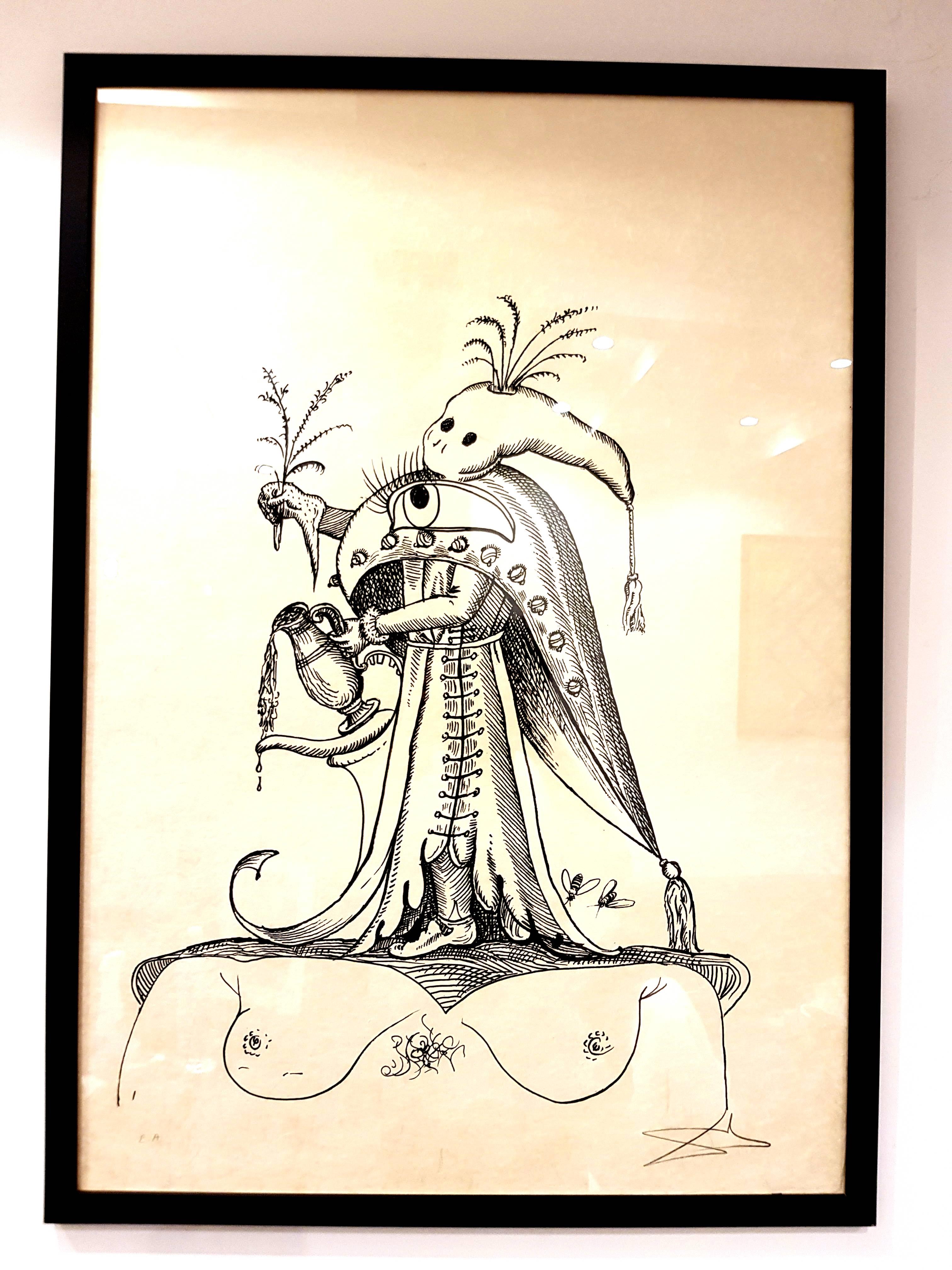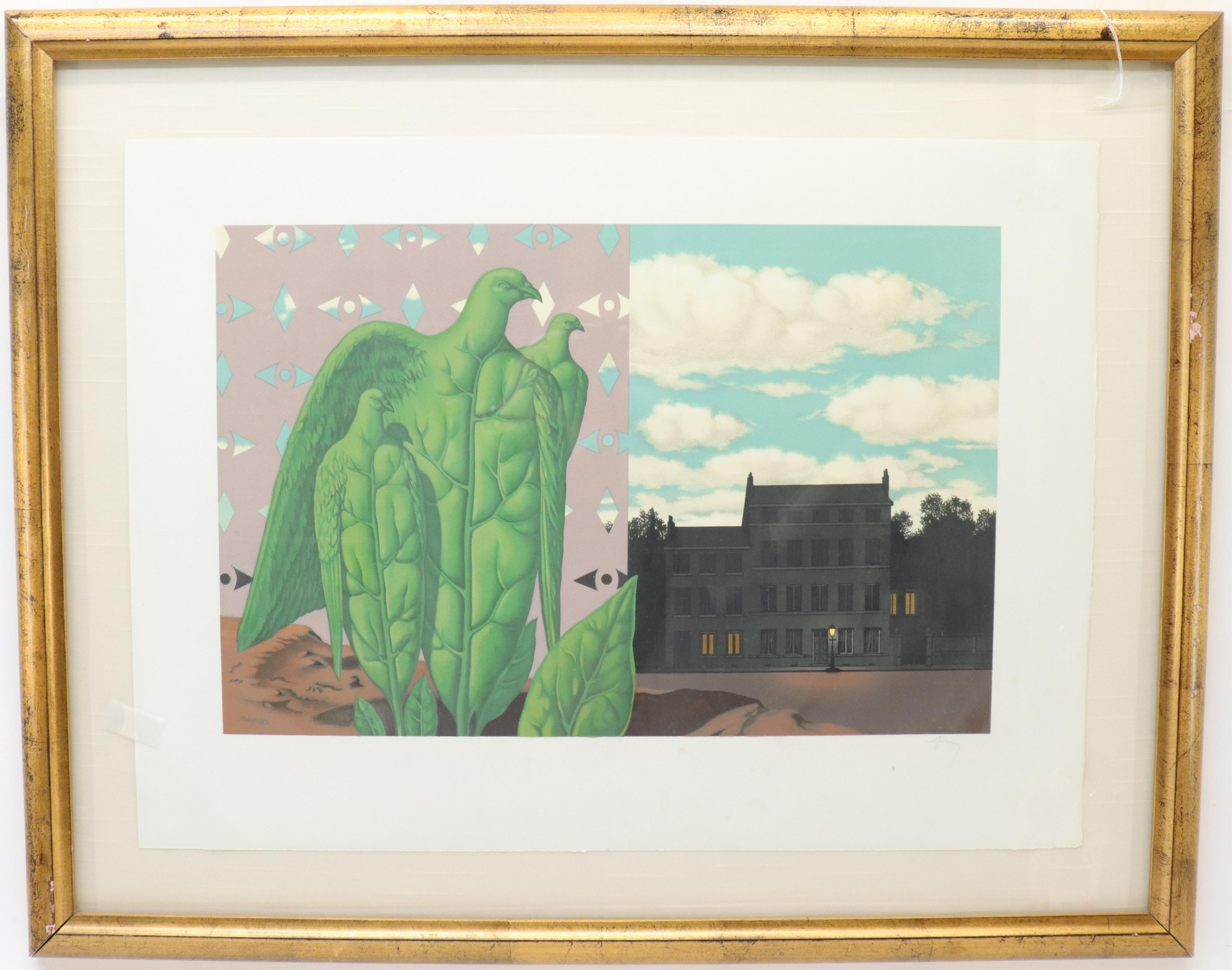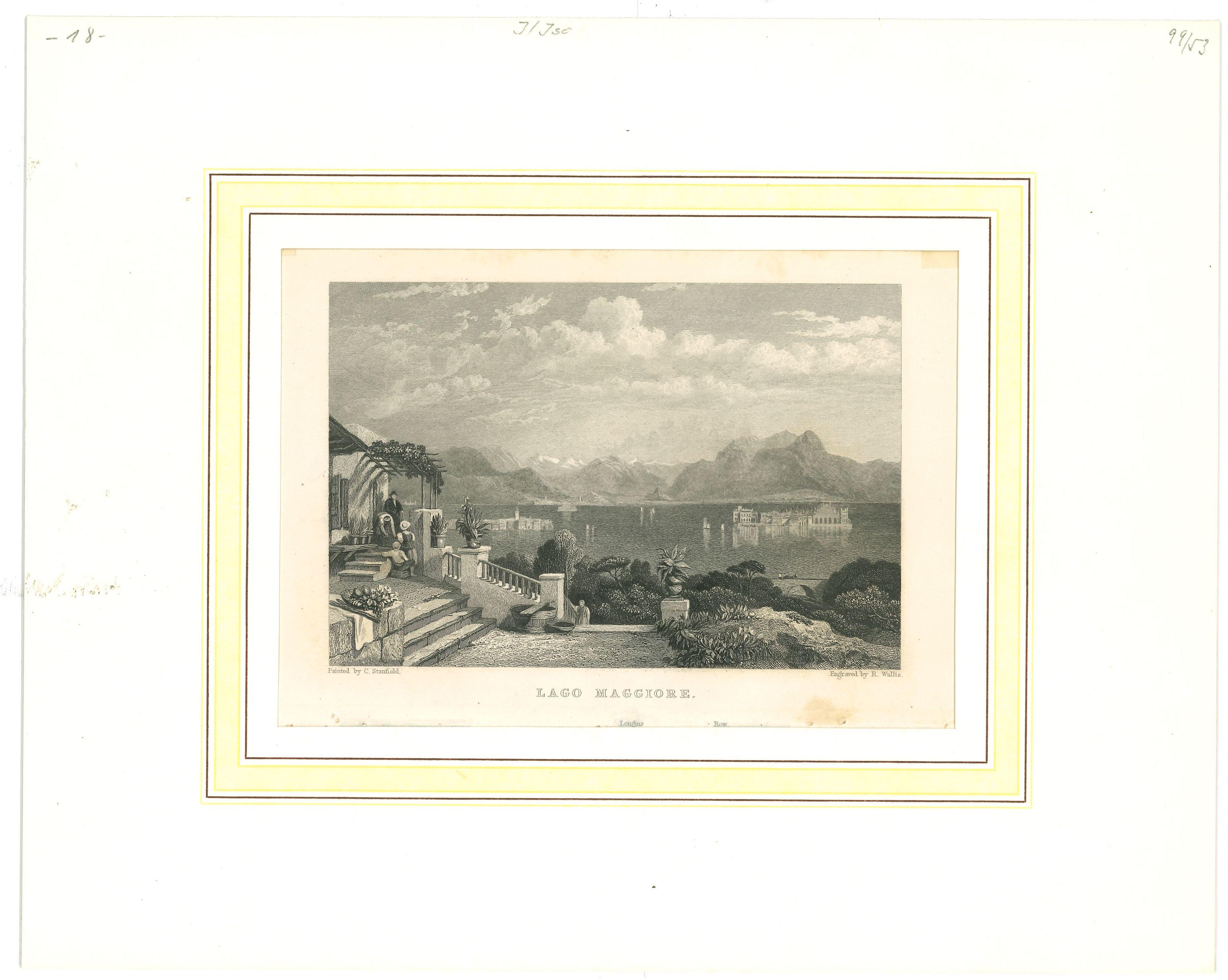Items Similar to Large Colorful Jerusalem Israeli Judaica Surrealist Lithograph on Heavy Paper
Want more images or videos?
Request additional images or videos from the seller
Baruch NachshonLarge Colorful Jerusalem Israeli Judaica Surrealist Lithograph on Heavy Paper
About the Item
THis is a fabulous, Surrealist lithograph in bright fauvist colors by Hasidic mystic Boruch Nachshon
It depicts jerusalem with King David and a menorah in a Jerusalem Landscape.
Baruch Nachshon, was born in Mandatory Palestine in 1939, in the city of Haifa.
Nachshon began to paint in early childhood, and developed his relationship to art and to artists throughout his youth. During his military service Nachshon herded flocks for the IDF, an experience that imbued in him a love and appreciation for nature which figures prominently in his work until today. Upon completing his military service the young artist was torn between the temptation to travel to Paris, then the cultural center of the art world, and his deep love of the land of Israel, the spiritual center of the Jewish world. Opting to stay in Israel, Nachshon studied under Shlomo Nerani, Cezanne’s only pupil, with whom he had enjoyed a deep friendship extending back to his childhood. Nachshon, whom Nerani viewed as his spiritual heir, was the only one of his students allowed to see the master at work.
Nachshon’s lifelong involvement in the Lubavitch Chassidic movement began in his early adulthood, when he was drawn to the movement by its uniquely beautiful traditional melodies. In 1965 Nachshon was invited to an unprecedented three- hour private session with the Rebbe of Habad Lubavitch, Menachem Mendel Schneerson, in New York. The young artist used the opportunity to share his concerns and misgivings about the role of the Jewish artist and the many inherent conflicts which confronted him. The Rebbe blessed Nachshon with the advice that for many generations the art of painting had failed to find its ultimate rectification in holiness, but that with the help of God he might come to bring about that long anticipated rectification. The Rebbe then offered to fund Nachshon’s studies in New York on the condition that he would find a program of study acceptable to Jewish religious values. Despite the difficulty inherent in such a task, Nachshon gladly received the Rebbe’s offer and devoted himself fully to the celebration of the wisdom of the Creator through visual art.
In 1967 Nachshon and his wife Sara, along with six other families renewed the Jewish presence in Hebron for the first time since the city’s Jewish residents were massacred by Arabs in 1929. To underscore the significance of Jewish culture to the city, Nacshon opened a gallery of his art beside the Tomb of the Patriarchs. During this period Nachshon also used to visit the houses of Hebron’s Arab residents in order to paint the city from unique angles. On one of his regular visits to the Tomb of the Patriarchs, Nachshon met an elderly Breslov Hassid. The hassid urged him to recite Psalms every night for forty days, and assured him that if he did so he would merit profound revelation. Nachshon did so, and as soon as the forty days had passed he saw the heavens open, receiving visions that would charge his art forever. Since that first time, Nachshon has seen the heavens open many times and, indeed, the opening of the heavens is a recurring motif in his work. According to Nachshon, “the open sky means going beyond what is reality, seeing through.”
Nachshon’s art covers a wide range of thematic material through equally diverse stylistic approaches, all of which are uniquely his own. He paints in order to define and to emphasize the presence of the active Divine Will in creation, and in order to inspire himself and others. Nachshon paints what he sees through the eyes of an inspired painter, communicating those visions to the world. Each of his paintings can be studied in the manner of a sacred text, providing numerous and vivid insights into the workings of creation and the promises held for the future. Many of his paintings describe visions of the future, of the world after its final redemption, of a world where all is peace and joy and where the revelation of divine beneficence is clear to all. Until that time, Nachshon’s paintings offer a glimpse of what could be, of what ought to be and of what will be when the work of humanity has reached its successful completion. Nachshon is one of the Chabad artists championed by the Chai Gallery in Crown Heights, Brooklyn New York.
they have represented all of the major Lubavitch Hasidic artists such as Michael Gleizer, Hendel Lieberman, Zalman Kleinman, Michoel Muchnik as well as artists such as Samuel Rothbort, Harry Mccormick, Meer Akselrod and the Rebbe photos of Fridrich Vishinsky.
The Artist’s Prayer
I express my gratitude to you, artisan of creation, for you have endowed me with the spirit of your holy inspiration.
I beseech you- in your vast kindness- impart to me more and more of your holy inspiration so that I may rejoice in you, and give cause for rejoicing to your creations. Give me inspiration to reveal your presence, even in the darkest places, because everything is from you and before your presence all darkness is also light. You created your universe, and within it crafted all of your creatures so that they would come to acknowledge you.
And so- this, indeed is all I ask- kindness! For there is nothing else, no words in our mouths sufficient to thank you for having created us, having made us your children- the Children of Israel- and having brought us close to you in order to serve you. You have drawn forth our spirit and illuminated all- Well of Life.
-Baruch Nachshon, Hebron, 5749
- Creator:Baruch Nachshon (1939, Israeli)
- Dimensions:Height: 29.5 in (74.93 cm)Width: 22 in (55.88 cm)
- Medium:
- Movement & Style:
- Period:
- Condition:never framed.
- Gallery Location:Surfside, FL
- Reference Number:1stDibs: LU3829392132
About the Seller
4.9
Platinum Seller
These expertly vetted sellers are 1stDibs' most experienced sellers and are rated highest by our customers.
Established in 1995
1stDibs seller since 2014
1,549 sales on 1stDibs
Typical response time: 1 hour
- ShippingRetrieving quote...Ships From: Surfside, FL
- Return PolicyA return for this item may be initiated within 3 days of delivery.
More From This SellerView All
- Surrealist Dream Lithograph Belgian Master Magritte Pencil Signed by MourlotBy (after) René MagritteLocated in Surfside, FLArtist: Rene Magritte (after), Belgian (1898 - 1967) Title: (from les Enfants Trouvés) Les Claires-Voies d'un Jeune Regard Embaument La Fête d'un V...Category
1960s Surrealist Landscape Prints
MaterialsLithograph
- Surrealist Dream Lithograph Belgian Master Magritte Pencil Signed by MourlotBy René MagritteLocated in Surfside, FLArtist: Rene Magritte (after), Belgian (1898 - 1967) Title: (from les Enfants Trouvés) Les Claires-Voies d'un Jeune Regard Embaument La Fête d'un V...Category
1960s Surrealist Landscape Prints
MaterialsLithograph
- 1936 Lithograph Soldiers in battle World War I small editionBy George GroszLocated in Surfside, FLAccording to the frontis these were produced by Hand Lithography. According to the Museum of Modern Art (MOMA NY) website "Edition:300 announced; only approx. 42 issued (including regular edition of 30, deluxe edition of approx. 10, and 2 artist's proofs)" I believe these are from the deluxe edition as they are on Mould made BFK Rives French paper and the dimensions are larger than stated in the MOMA website. the sheet size here is 40X29 cm. Date 1936. Publisher:Black Sun Press, New York. Printer:George C. Miller & Son, New York. most of them are plate signed. George Grosz (July 26, 1893 – July 6, 1959) was a German artist known especially for his Satire and Caricature drawings of Berlin life in the 1920s. He was a prominent member of the Berlin Dada and New Objectivity group during the Weimar Republic before he emigrated to the United States in 1933. He studied at the Dresden Academy of Fine Arts, where his teachers were Richard Müller, Robert Sterl, and Oskar Schindler. He subsequently studied at the Berlin College of Arts and Crafts under Emil Orlik. Grosz left the Communist Party KPD in 1922 after having spent five months in Russia and meeting Lenin and Trotsky, because of his antagonism to any form of dictatorial authority. Along with Otto Dix, he is widely considered one of the most important artists of the Neue Sachlichkeit. Bitterly anti Nazi, Grosz left Germany shortly before Hitler came to power. In June 1932, he accepted an invitation to teach the summer semester at the Art Students League of New York. In October 1932, Grosz returned to Germany, but on January 12, 1933 he and his family emigrated to America. In 1946 he published his autobiography, A Little Yes and a Big No. In the 1950s he opened a private art school at his home and also worked as Artist in Residence at the Des Moines Art Center. Grosz was elected into the National Academy of Design as an Associate Academician in 1950. In 1954 he was elected to the American Academy of Arts and Letters. Grosz worked in a style influenced by Expressionism and Futurism, as well as by popular illustration, graffiti, and children's drawings.The City (1916–17) was the first of his many paintings of the modern urban scene. Other examples include the apocalyptic Explosion (1917), Metropolis (1917), and The Funeral, a 1918 painting depicting a mad funeral procession. In his drawings, usually in pen and ink which he sometimes developed further with watercolor, Grosz did much to create the image most have of Berlin and the Weimar Republic in the 1920s. Corpulent businessmen, wounded soldiers, prostitutes, sex crimes and orgies were his great subjects His draftsmanship was excellent although the works for which he is best known adopt a deliberately crude form of caricature. His oeuvre includes a few absurdist works, and also includes a number of erotic artworks. ("Ecce Homo" which saw him accused of pornography) My Drawings expressed my despair, hate and disillusionment, I drew drunkards; puking men; men with clenched fists cursing at the moon. ... I drew a man, face filled with fright, washing blood from his hands ... I drew lonely little men fleeing madly through empty streets. I drew a cross-section of tenement house: through one window could be seen a man attacking his wife; through another, two people making love; from a third hung a suicide with body covered by swarming flies. I drew soldiers without noses; war cripples with crustacean-like steel arms; two medical soldiers putting a violent infantryman into a strait-jacket made of a horse blanket ... I drew a skeleton...Category
1930s Landscape Prints
MaterialsLithograph
- Japanese Woodblock Artist French Lithograph Fauvist Colors School of ParisBy Shungo SekiguchiLocated in Surfside, FLShungo Sekiguchi, (Japanese, 1911-2002): Lithograph in color on Rives paper Hand signed in pencil lower right, hand numbered It appears to be the village of Montmarte in Paris This was published by the Guilde de la Gravure, Paris, France and bears their GG blindstamp. They were a mid century French art publisher and published many masters including Raoul Dufy, Max Erns, Jean Hans Arp, Ruffino Tamayo, Balthus, Gino Severini and Leonard Tsuguharu Foujita. Shungo Sekiguchi was born 1911 in Japan. In 1932 Shungo Sekiguchi contributed to the print series "One Hundred Views of Great Tokyo" (Dai Tokyo hyakkei). Prints from watercolors published by Kaneda Shoten (Nihon Hanga Ken-kyusho). In 1935, Sekiguchi moved to Paris, France to study at the prestigious Ecole des Beaux Art of France with a scholarship of the French government. He studied together with two other Ecole de Paris Japanese artists, Takanori Ogisu and Tsuguji Foujita. He exhibited at the prestigious "Salon d'Automne" in Paris. In 1940 when Paris was occupied by the German Nazis, Shungo Sekiguchi returned to Japan, but kept his ties with France. In 1952 he exhibited at the famous Salon d'Automne and received an award. In 1959, he received an award at the Vicci International Art Contest. In 1964, he received the Diplome d'Honneur des at Jobiji International Art Show. His retrospective exhibition has been held in many places in Japan. In 2002 the artist died in Japan. He is popular in Japan and several retrospective exhibitions were held in Japan. He was part of the Shin Hanga and Sosaku Hanga woodblock artists known for their woodcut prints and scrolls. Shin-hanga was an art movement in early 20th-century Japan, during the Taisho and Showa periods, that revitalized traditional ukiyo-e art rooted in the Edo and Meiji periods. He also worked as a book illustrator and did the artwork for the French edition of Le démon doré by Ozaki Kohyo. He is included in Helen Merritt and Nanako Yamada's classic book "Guide to Modern Japanese Woodblock...Category
1950s Post-Impressionist Landscape Prints
MaterialsLithograph
- Israeli Folk Art Hebrew Naive Judaica Lithograph Jewish Holiday ShavuotBy Shalom MoskovitzLocated in Surfside, FLVintage pencil signed and numbered limited edition lithograph on deckle edged Arches paper. Shalom of Sefad (Shulem der Zeigermacher in Yiddish Shalom Moskowitz) Shalom of Tzfat liv...Category
20th Century Folk Art Figurative Prints
MaterialsLithograph
- 1970 Silencio, Direccion Unica, One Way Spanish Political Etching Pop Art PrintBy Juan GenovesLocated in Surfside, FLJuan Genovés Candel (Spanish, 1930-) Painter, illustrator, and graphic printmaker engraver. He painted 'El abrazo' ('the embrace'), which became an emblematic poster during the Spanish political transition. He was born in Valencia in 1930. The son of Juan Genovés Cubells, an artisan whose family was close to the labor movement. His mother Maria Candel Muñoz came from a family of practicing Catholics. In 1946 Genovés studied at the Escuela de Bellas Artes de San Carlos in Valencia and then settled in Madrid. He set up the 'Los Siete' group together with other artists in 1949, and the following year he travelled to Madrid, where he was influenced by the works by Fra Angélico and Hieronymus Bosch in the Prado Museum. In 1957 he had his first solo exhibitions in the gallery Alfil, Madrid and in the Museo d'Arte Moderna, Havana. He is considered the most important representative of modern Spanish painting. His images, executed in a politically engaged, critical realism...Category
1970s Pop Art Figurative Prints
MaterialsLithograph
You May Also Like
- Salvador Dali - Les Songes Drolatiques - Handsigned LithographBy Salvador DalíLocated in Collonge Bellerive, Geneve, CHHand-Signed Lithograph by Salvador Dali Japan Paper Title: Pantagruel's Dreams Signed in Pencil by Salvador Dali Dimensions: 76 x 56 cm Edition: EA 1973 References : Field 73-7 (p. 1...Category
1970s Surrealist Figurative Prints
MaterialsLithograph
- Salvador Dali (after) - New-York: Plaza (poster edition) - LithographBy (after) Salvador DaliLocated in Collonge Bellerive, Geneve, CHLithograph after an original watercolor by Salvador Dali Title: New-York City : Plaza (pre-text/"avant la lettre" poster edition) Printed Signature, da...Category
1960s Surrealist Figurative Prints
MaterialsLithograph
- Ancient View of Lago Maggiore - Lithograph on Paper - Mid-19th CenturyLocated in Roma, ITAncient View of Lago Maggiore is an original modern artwork realized in Italy in the first half of the 19th Century. Original Lithograph on Ivory Paper...Category
1850s Surrealist Figurative Prints
MaterialsLithograph
- Flights of Fancy original lithograph by Michel Pellus 1977By Michel Pellus 1Located in Paonia, COFlights of Fancy is an original signed limited edition (060/250 ) lithograph by Michel Pellus showing a man in a top hat floating in the sky in a hot a...Category
1970s Surrealist Figurative Prints
MaterialsLithograph
- Le Marriage de la Vierge by Salvador Dali Changes in Great Masterpieces seriesBy Salvador DalíLocated in Paonia, COLe Marriage de la Vierge by Salvador Dali and interpreted from the original Raphael painting is one of six graphics from the series Changes in Great Masterpieces...Category
1970s Surrealist Figurative Prints
MaterialsLithograph
- Velasquez Le Reddition De Breda by Salvador Dali 1974 lithographBy Salvador DalíLocated in Paonia, COVelasquez Le Reddition De Breda is one of six graphics from the series Changes in Great Masterpieces published by Sidney Lucas, ...Category
1970s Surrealist Figurative Prints
MaterialsLithograph
Recently Viewed
View AllMore Ways To Browse
Surrealist Photo
Israel Menorah
Israeli Menorah
Jewish Menorah
Visions Of Jerusalem
Paintings Brooklyn Heights
Brooklyn Heights Painting
Jewish Prayer Art
Jerusalem Menorah
Judaica Menorah
Israel Arab
The Joy Of The Blessed
Everything Else Has Failed
Large Judaica Paint
Holy Land Vintage
Chai Vintage
Large Menorah
Menorah Painting





